Family : Fabaceae

Text © Prof. Pietro Pavone

English translation by Mario Beltramini
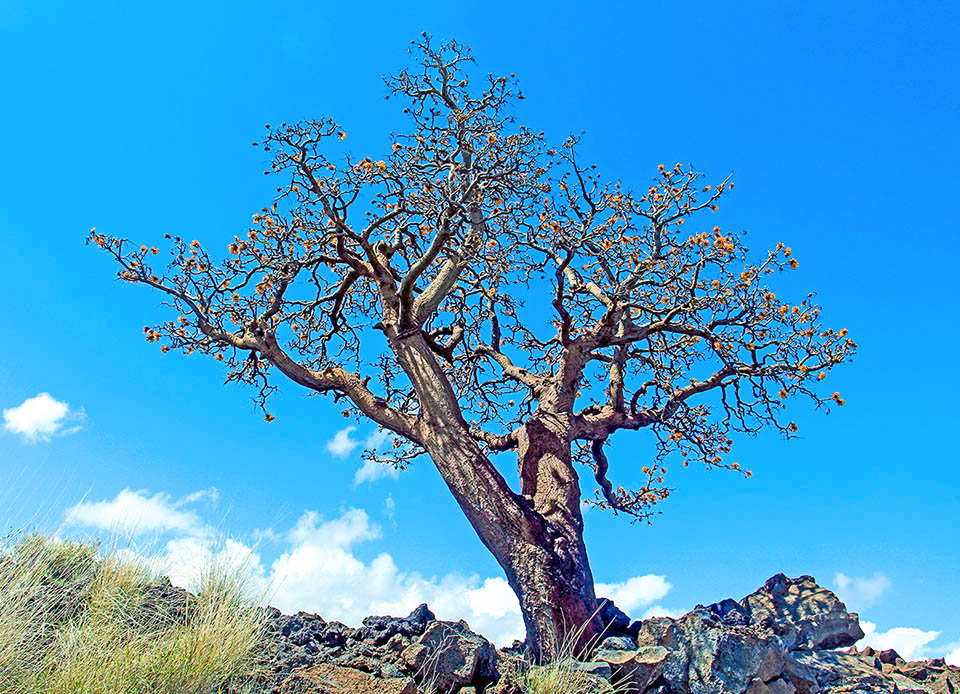
Erythrina sandvicensis is a small deciduous tree, even 15 m tall, endemic to the Hawaii Islands and included as “Vulnerable” in the Red List © J. B. Friday
Erythrina sandwicensis O.Deg. (1932) belongs to the family Fabaceae, subfamily Faboideae, tribe Phaseoleae. It is a species endemic to the Hawaii Islands, only native of the genus Erythrina. It is typically found in the dry tropical Hawaiian forests, on the leeward slopes, up to an altitude of 600 m.
The Hawaii Islands, having continuously included islands during the last 30 million years, represent the oldest archipelago of emerged and submarine volcanoes of the Pacific Ocean. It is estimated that their formation is connected with the presence of a hot spot in the Earth’s mantle that began to take form during the last 70 million years. When the lava solidified, on the islands any form of life existed. It was the wind and the birds (long distance dispersion) who brought the first seeds from which then a thick forest took life, thanks to the fertility of the volcanic soil.
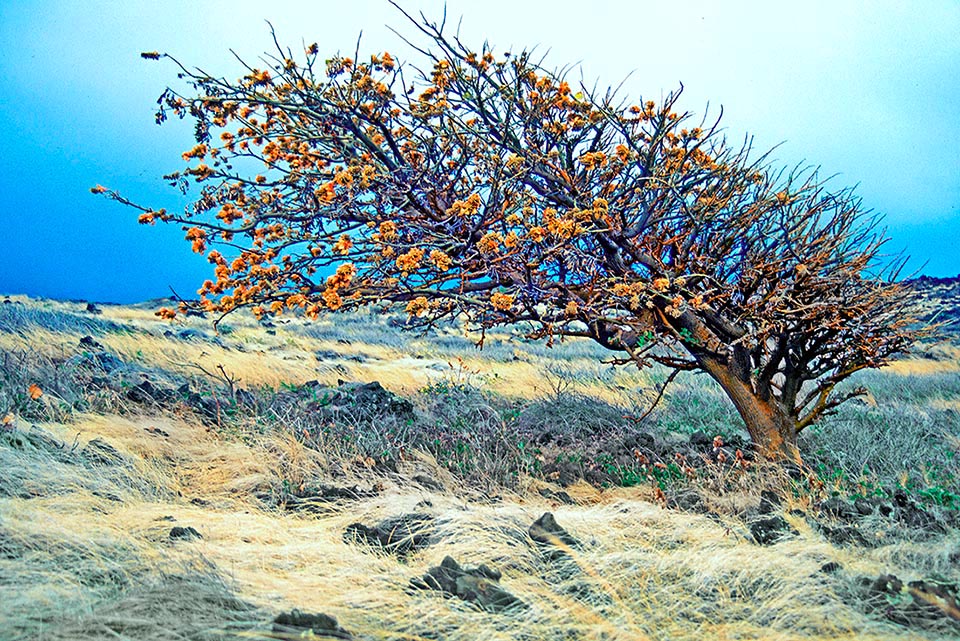
It typically grows in the dry forests, on the lee slopes close to the ocean up to an altitude of about 600 m © Keoki Stender
Compared to other islands of the central Pacific, the Hawaii islands are the closest ones to the Neotropical region (Neotropic), to North America and eastern Asia. As a matter of fact, Erythrina sandwicensis is strongly related to the endemic Tahitian species Erythrina tahitensis Nadeaud and to Erythrina velutina Willd. of the Neotropical realm (Brazil, Peru, Ecuador, Colombia, Venezuela and Hispaniola). It is quite likely, therefore, that the long distance dispersion of Erythrina has left from the Neotropical realm reaching the Hawaii Islands and then, from these last, went all the way to Tahiti.
The term Erythrina comes from the Greek ἐρυϑρός (erythros), red, alluding to the large flowers of some species of the genus. The specific epithet refers to the Hawaii Islands in the past called Sandwich Islands, name that the explorer James Cook (1728-1779) gave to these islands when he discovered them in 1778.
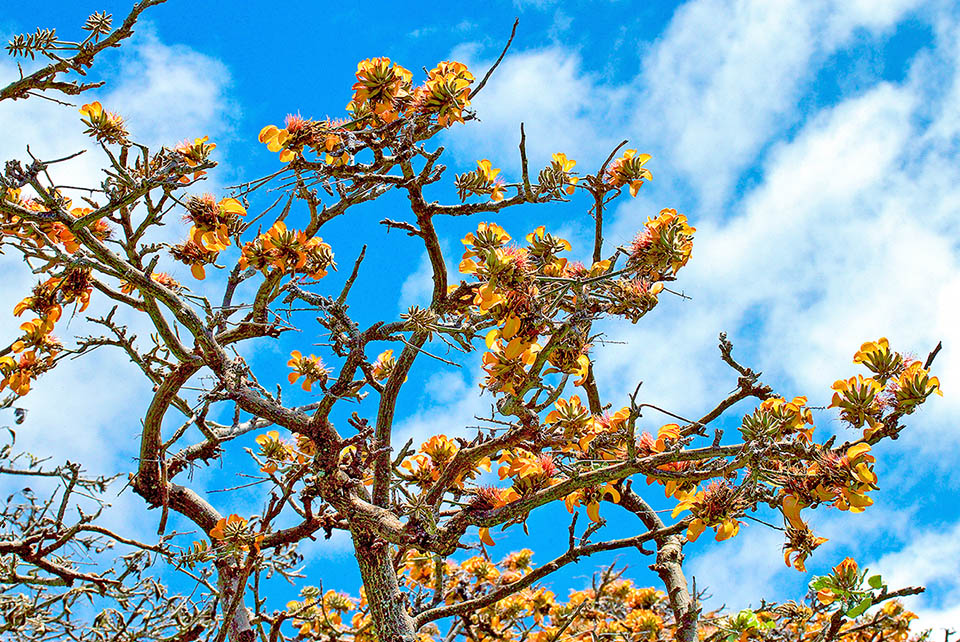
The flowers carried by a short peduncle, bloom in late winter, before the leaves © Keoki Stender
In this way he wanted to honour John Montagu (1718-1792), British noble, admiral and diplomat, 4th Earl of Sandwich.
A particularity of this British noble title refers to the name, still used today, of the filled sandwiches. In fact, it is said that John Montagu was a keen card player and was betting large sums of money, therefore, could not afford to have the game interrupted. However, doing so, often was forced to give up lunches and dinners. One day, since the game had been going on for many hours, he asked one of his attendants to bring him some slices of meat between two pieces of bread. In this way he could go on playing cards with one hand while with the other he could eat his meal.
The other players, they too, fasted for the extremely long game, asked the waiter to bring them “the same as Sandwich”. Thus the name of the sandwich was born.
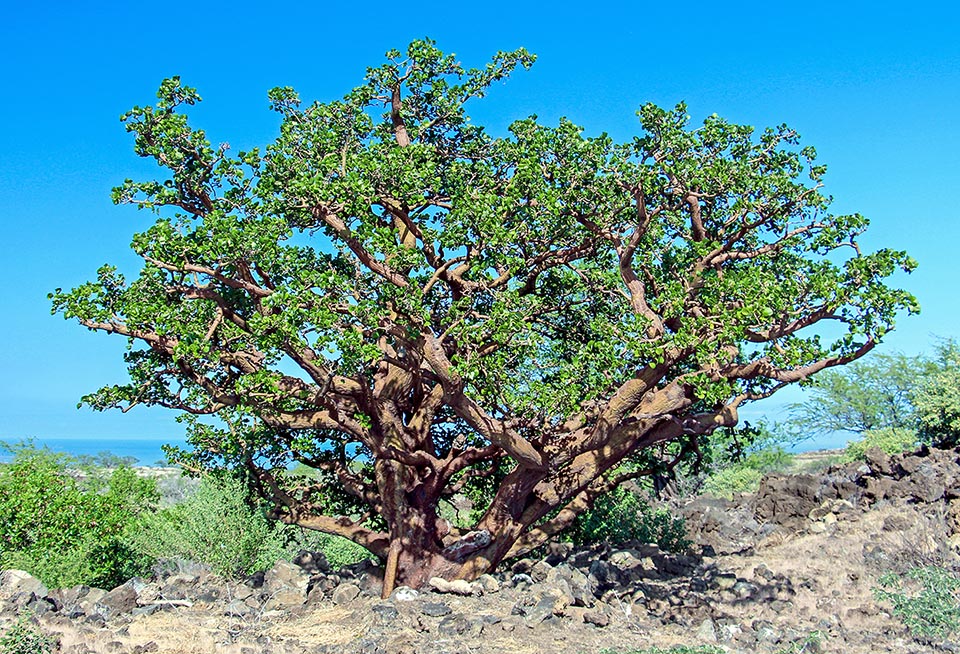
To not disperse water the leaves appear usually after blooming, from spring to mid summer, when the soil is humid © J. B. Friday
Erythrina sandwicensis, in the Hawaiian language, is called Wiliwili, that means “twisted-twisted, repeatedly twisted” and refers to the dehiscence of the seedpods for freeing the seeds. Erythrina sandwicensis has been recently included in the IUCN Red List of the endangered species as vulnerable (VU).
In the past it has been an important element of the old forests endemic to the Hawaiian drylands but recently in many areas it has been replaced by a species native to South America Prosopis pallida (Willd.) Kunth, more resistant to disease.
Erythrina sandwicensis is a small deciduous tree that may reach the height of 15 m with a trunk of 30-90 cm of diameter, short, robust, sometimes gnarly.
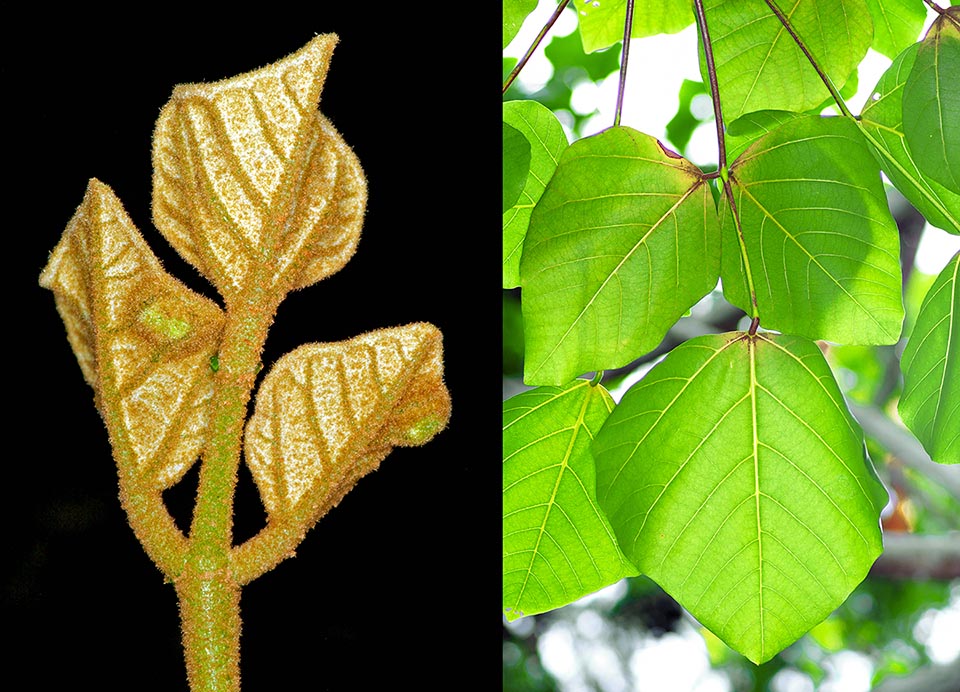
They are compound, up to 30 cm long, formed by 3 leaflets supported by a long and thin petiole. Growing veins are hairy and in relief on the lower pagina © Keoki Stender
The branches spread out forming a large crown. The bark is smooth, slightly fissured and thin with the age, of pale brown colour tending to reddish, with up to 1 cm long greyish thorns. The branches are robust, green, pubescent when young, with scattered blackish spines.
The leaves are alternate and up to 30 cm long, supported by a long and thin petiole. They are compound, that is formed by three leaflets, with short petiole, round or triangular in shape (4-10 cm long and 6-15 cm broad), two paired and one bigger at the extremity, hairy in the lower pagina, with raised veins and with two punctiform glands at the base of each one and one or two glands at the base of the foliar petiole.
The leaves fall in late summer or in early autumn (August to October) and reform again from early spring to mid summer (March to July), usually after the blooming.
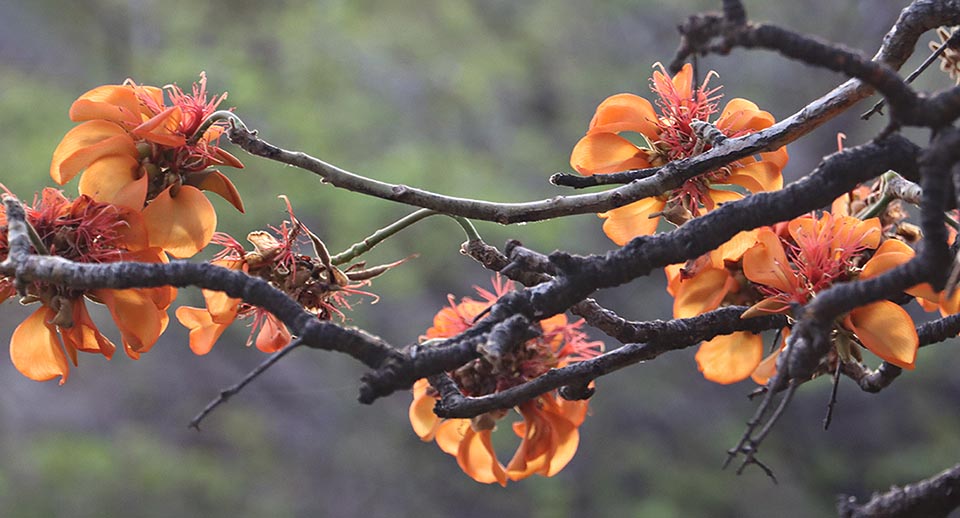
The papilionaceous flowers, 7,5-15 cm long, have a bigger petal, called vexillum, two lateral and two lower ones merged in order to protect the reproductive organs © J. B. Friday
In Maui island, in some populations, it has been observed that the leaves fall off during the dry periods of late spring or of early summer (May to June) whilst other new ones originate after the first storms in late autumn (November).
It is thought that this fall is the response of the plant, in order not to waste the water, due to the variations of the humidity of the soil.
The flowers, on a short peduncle, are zygomorphic (irregular), 7,5-15 cm long, of papilionaceous shape, that is formed by a bigger petal standing above and bound upwards, called vexillum, by two lateral petals, the wings, and by two lower petals, merged, forming the keel that includes the reproductive elements. The flowers are supported by yellowish stems, hairy, of 7,4 cm or less, grouped in a way to form raceme inflorescences.
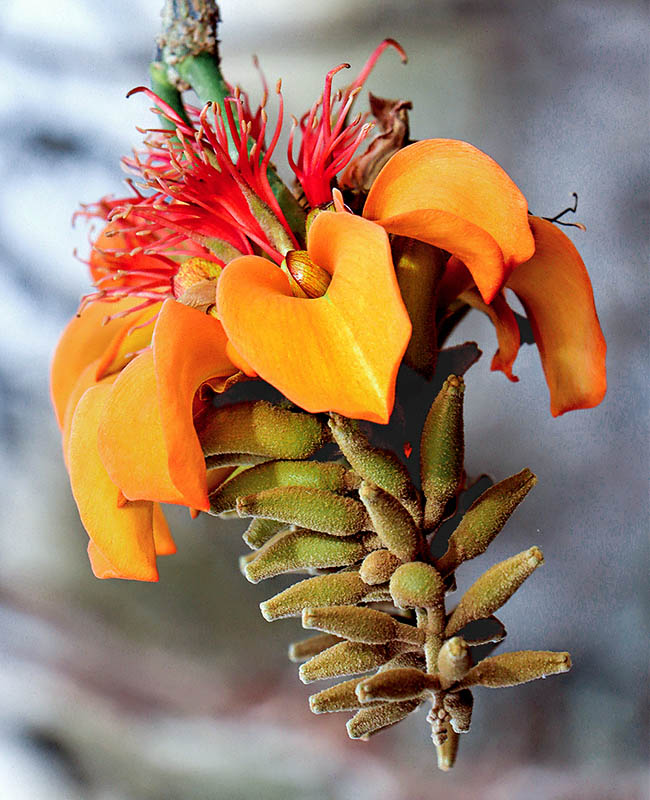
The raceme inflorescence has several buds. With their weight they curve downwards the stems overturning vexillum © J. B. Friday
The colour of the flowers can be orange, yellow, salmon, green or white, a rather rare characteristic within the genus.
Pollination is done by birds.
Due to the disappearance of the autochthonous species, now, the flowers are amply pollinated by Zosterops japonicus Temmink and Schlegel 1847, known as Japanese white-eye, introduced on 1929 on the island of Oahu from where has diffused on all the Hawaiian islands, becoming the most common bird of the archipelago.
During the winter months (from December to February) take form on the plant about 10 cm long and 13 mm broad pods, flattened, sharp at the extremities, containing 1 to 4 seeds.
These, of elliptical shape, are 13-15 mm long and are of glossy orange red colour.
Erythrina sandwicensis has a brown or pale yellow wood, very light and soft.
In the past the local populations utilized them for making surfboards, floats for fishing nets and for stabilizing the canoes.
This last use was abandoned because the Hawaiians believed that the sharks followed the canoes stabilized with this wood.
The seeds were used to make wreaths.
A crown of seeds was given to Capt. Cook himself when he did visit the islands in 1778, but when he came back to Hawaii, after a violent confrontation between his men and the natives, he was killed in 1779. The species is part of Hawaiian culture also through legends and proverbs. The Hawaiians believed that the blooming along the coast did render the sharks more aggressive.
Erythrina sandwicensis forms symbiosis with species of the genus Bradyrhizobium (Gram-negative soil bacteria) for fixing the atmospheric nitrogen (N2) in forms immediately available like the nitrates. And, recently, have been identified very effective strains, useful for the vigorous growth of the inoculated plants.
In phosphorus-free soils recourse is done to the inoculation of VAM (vesicular-arbuscular mycorrhizal) fungi such as Glomus fasciculatum that, increasing the absorbent root surface, leads to an effective growth of the plants and to a decrease of the need for phosphorus fertilizer.
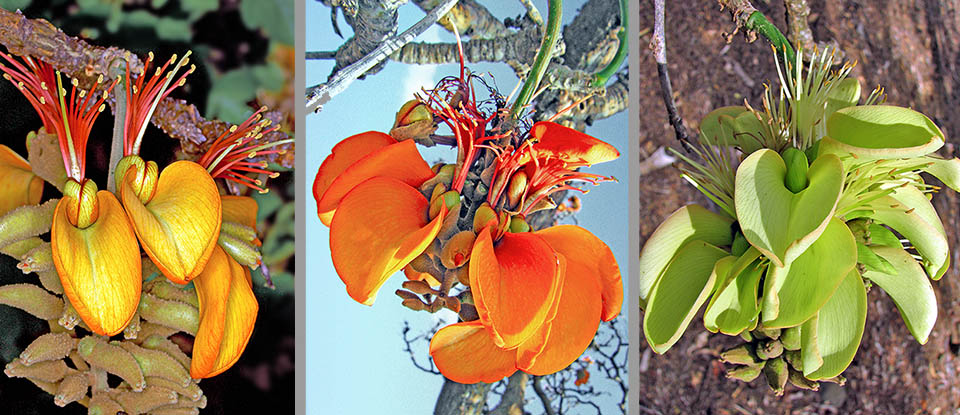
The colour of the flowers may be orange, yellow, salmon, green or white, fairly rare characteristic within the genus © Keoki Stender © Rosa Say © David Eickhoff
As a matter of fact, the fungi act as intermediaries on the mineral nutrition of the plants because they put into the ground both protons, that is subatomic particles having a positive electric charge, and enzymes, able to convert the mineral elements from the insoluble form to the soluble one. As a consequence, the mycorrhizae are suitable for the absorption and accumulation of the phosphorus and allow the plant to utilize the ammonium and the organic nitrogen, resources otherwise unusable.
Due to activities related to the human presence and in particular the accidental introduction of the wasp Quadrastichus erythrinae Kim, 2004 that causes galls on leaves, stems, petioles and young buds of Erythrina sandwicensis, has occurred an important reduction of the populations. It is believed that this invasive wasp has had its origin in Africa dispersing rapidly through southern Asia, the Pacific, and southern North America then reaching, in the early years of the 21st century, to the Hawaii causing the death of the native forests of Erythrina sandwicensis.
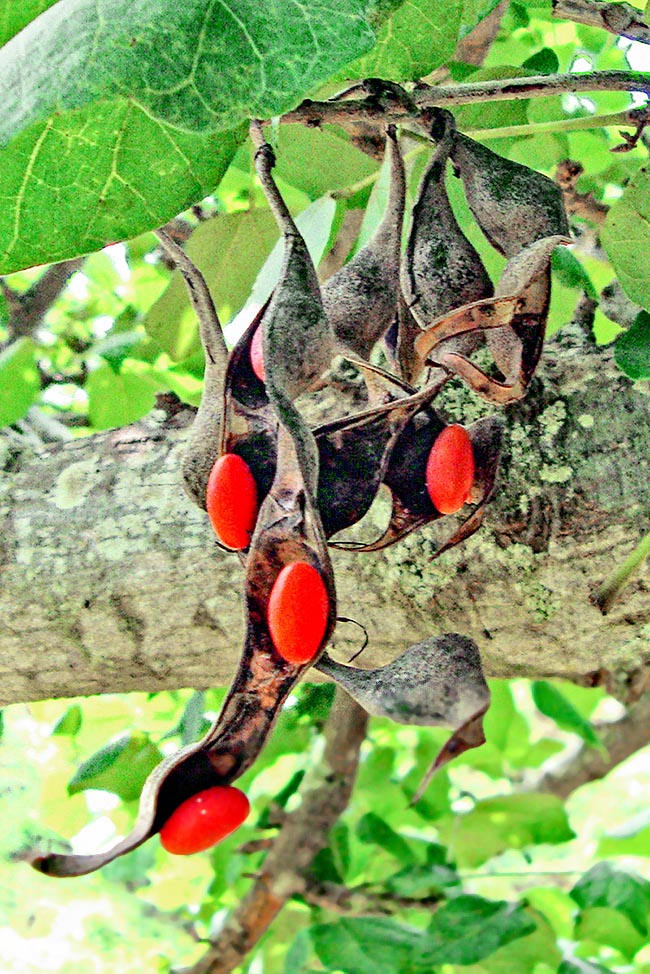
The glossy orange red seeds grow in flattened, about 10 cm long, pods and twisted when ripe © Tim Kroessig
It has already been found before 2001 in the forest of Puú O Kali, located under the crater of Haleakala on the island of Maui.
To curb this, recently, as biocontrol agent, has been introduced the parasitoid wasp Eurytoma erythrinae Gates & Delvare, 2008, that has proven to be very effective in reducing the population of the gallogenic wasps of Erythrina.
It is also planned the introduction of a second parasitoid wasp from Africa: Aprostocetus nitens Prinsloo & Kelly, 2009.
Moreover, to make up for the losses, recently, the Forest Division has planted more than 6000 trees of Erythrina sandwicensis in the Forest Reserves, many of which in the island of Molokai.
It is a species particularly suitable for land rehabilitation in heavily eroded areas. In fact, it is able to survive prolonged drought and strong winds, even if the growth is very slow.
Erythrina sandwicensis is a species that can be easily reproduced by seed or by cutting.
The seeds are mechanically scarified engraving the coating and are immersed in water (at room temperature) for one night.
Then they are interred 4 cm adding to the loam a small quantity of slow release fertilizer based on N-P-K (14, 14, 14).
To speed up the growth it is good practice to utilize the mycorrhizal inoculant VAM that must be mixed also into the loam. The seedlings are to be kept in a shady zone until the first leaves appear. To give water only if necessary because the excessive irrigation may cause disease such as the dimming caused by fungi. After two weeks, the plants are to be placed in full sun.
The multiplication by cuttings is done with branches having a diameter of 2,5 cm and a length of about 30 cm. The cuttings after the cut are dried in open air for at least 24 hours. It is good to immerse the base of the cutting in a rooting hormone. Later on, they are interred at a depth of about 15 cm, and the loam is to be maintained humid. It is good to seal the upper part of the cuttings with wax or other sealing material in order to prevent excessive water loss.
When the stems are robust and well hardened, after about four months, the seedlings are ready to be permanently settled on well drained soils and in full sun having characteristics similar to its natural environment.
Synonyms: Erythrina monosperma Gaudich.
→ To appreciate the biodiversity within the family of FABACEAE please click here.
